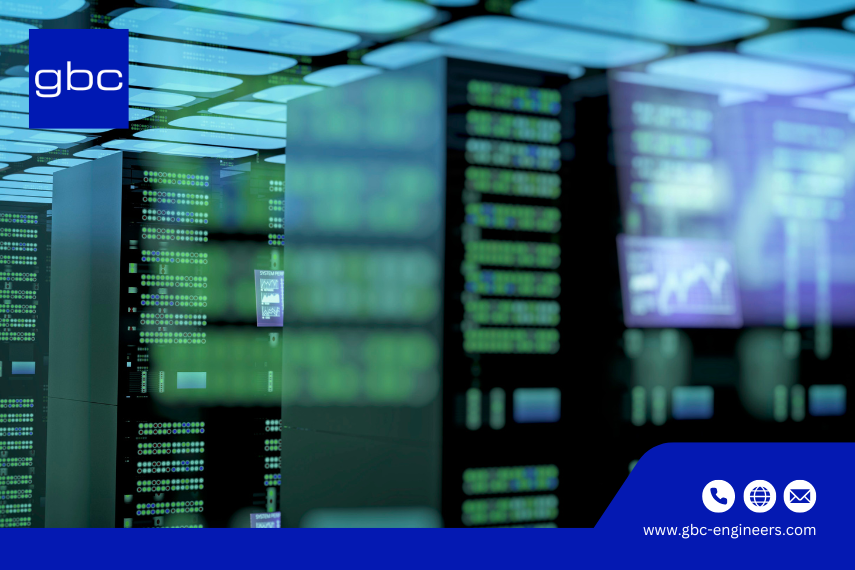In today’s interconnected world, where digital services must remain available 24/7, data centers have become the invisible backbone of our global economy. These facilities store, process, and distribute the data behind cloud platforms, financial services, e-commerce, video streaming, and AI-powered applications. At the heart of any high-performing, reliable data center is a critical discipline: data center design.
Whether it's a hyperscale campus, an enterprise facility, or an edge data center supporting IoT or 5G applications, the success of the entire operation starts with smart design.
Discover what is data center design and how gbc engineers delivers innovative infrastructure solutions for your IT needs.
What Is Data Center Design?
Data center design refers to the comprehensive planning and engineering process that defines the structure, systems, and functionality of a modern data center facility. It encompasses the layout of server rooms, data center infrastructure, electrical and mechanical infrastructure, air conditioning and cooling systems, power supplies, physical security measures, and security protocols. It also includes integration with cloud computing platforms and collaboration with various service providers, along with scalability and disaster recovery strategies.
Effective design ensures that the team managing the facility has access to the right resources and infrastructure to support seamless, reliable, and secure IT operations, including robust uninterrupted power solutions to maintain uptime during power disturbances.
Good design is not just about aesthetics or physical layout—it’s about ensuring resilience, optimizing energy efficiency, and enabling robust support for both traditional workloads and modern cloud services. A well-designed data center must handle ever-growing data demands while maintaining high uptime, low latency, and energy efficiency.
Why Data Center Design Matters
Poor planning in a data center infrastructure can lead to system failures, overheating, inefficient energy use, excessive operational costs, equipment damage, and limited scalability. In contrast, an intelligently designed facility—whether for enterprise use or colocation—can deliver:
- High availability (uptime) through redundancy, fault tolerance, and robust power supply systems including uninterrupted power solutions
- Operational efficiency through optimal layout, equipment management, energy efficient technologies, and the use of switch mode power supplies
- Scalability to accommodate future growth in capacity without major overhauls
- Security and privacy compliance with industry regulations
- Reduced carbon footprint through the integration of renewable energy sources and sustainable energy sources
In an era where data is a mission-critical asset, downtime can cost a company thousands—even millions—of dollars per minute. Design, therefore, is not just an engineering consideration; it’s a strategic business decision. With the right team and sufficient planning time, a data center can become a resilient, secure, and high-performing backbone of digital infrastructure.

Key Components of Data Center Design
Site Selection and Environmental Factors
Site location influences everything from latency to resilience—and choosing the right site is a critical service that can significantly impact the long-term success of data center technologies. Ideal locations offer:
- Access to reliable electricity and network connectivity, saving time and reducing operational risks
- Low natural disaster risk (earthquakes, floods, storms) to ensure consistent service delivery
- Proximity to business hubs or user bases, supporting faster connections for organizations and end users
- Favorable climate for natural cooling or free-air cooling, lowering energy costs and supporting sustainable careers in green engineering
- Compliance with local building and environmental regulations to future-proof infrastructure and support global organizations
Architectural and Structural Layout
A data center's physical layout must balance accessibility, airflow, and future expansion—critical considerations for modern businesses relying on seamless digital operations. This includes:
- Rack configuration using hot aisle/cold aisle containment to optimize cooling
- Structural separation of electrical, IT, and mechanical spaces to enhance safety and maintainability
- Load-bearing capacity of slabs and raised floors to support heavy equipment and future upgrades
- Floor-to-ceiling heights to accommodate ducting and cabling, ensuring flexibility for evolving technologies
- Modular or scalable designs that allow phased growth, offering a practical guide for long-term infrastructure planning
This foundational approach empowers businesses to make informed decisions, build with confidence, and adapt as their needs evolve.
Electrical Infrastructure and Redundancy
Power reliability is vital. A resilient design includes:
- Dual utility feeds and on-site substations
- UPS systems to protect against power interruptions
- Diesel or gas-powered generators for long-term outages
- Power Distribution Units (PDUs) and Remote Power Panels (RPPs)
- Redundancy configurations (N+1, 2N, 2(N+1)) to ensure uptime
Read More: Top 10 Best Practices for Data Center Design and Implementation - gbc engineers
Mechanical Systems and Cooling Strategies
Cooling is often the largest operational expense in a data center. Effective designs feature:
- CRAC/CRAH units with precision temperature control
- In-row, rear-door, or overhead cooling systems
- Liquid cooling for high-density server racks
- Airflow management through containment systems
- Use of economizers for free cooling from ambient air
IT and Network Architecture
The networking backbone must offer both speed and redundancy. Design considerations include:
- Structured cabling following ANSI/TIA-942 standards
https://tiaonline.org/products-and-services/tia942certification/ansi-tia-942-standard/
- Redundant network paths and BGP routing for failover
- Carrier-neutral meet-me rooms (MMRs)
- Access to multiple ISPs for resilience and performance
- Edge nodes or micro data centers for low-latency processing
Read More: Typical Data Center Layout: Core Components and Infrastructure - gbc engineers
Physical and Cybersecurity
Multi-layered security is required to protect both hardware and sensitive data:
- Fencing, surveillance cameras, and motion sensors
- Biometric access controls and airlock mantraps
- Compartmentalization of zones (IT rooms, power rooms, admin)
- Fire suppression systems (e.g. FM-200, Novec 1230)
- Environmental sensors (temperature, humidity, smoke, leak)
Scalability, Modularity, and Lifecycle Planning
Data centers must evolve with business needs. Smart designs incorporate:
- Modular components for electrical and mechanical systems
- Flexible space planning for future IT loads
- Infrastructure Monitoring (DCIM) tools for predictive maintenance
- Building Information Modeling (BIM) to visualize growth paths
- Lifecycle cost analysis, including total cost of ownership (TCO)
Read More: Data Center Services: Types, Importance, and Trends in 2025 - gbc engineers
Leading Standards in Data Center Design
Several international standards define the framework for reliable, efficient, and safe data center operations:
Uptime Institute Tier Classification
Tier I–IV ratings assess availability, fault tolerance, and maintenance capabilities.
Tier IV offers the highest level of resilience and fault tolerance.
ANSI/TIA-942
Defines infrastructure requirements for cabling, cooling, power, and space planning.
Specifies four rating levels for resilience and redundancy.
BICSI 002
Comprehensive design and implementation standard covering all aspects of physical infrastructure.
ISO/IEC 22237 & ISO/IEC 24764
ISO standards for data center performance and structured cabling systems.
LEED and Green Building Certifications
Recognize sustainability efforts in energy and water use, materials, and emissions.
ASHRAE 90.4 & TC9.9
Provide guidelines for energy efficiency and thermal management within data centers.
Future Trends in Data Center Design
As technology evolves, so does the way we design and operate data centers. Notable trends include:
- Liquid cooling systems to handle high-density HPC and AI workloads
- Micro/modular data centers for edge computing and remote locations
- AI-powered operations for predictive maintenance and energy optimization
- Digital twin technology for simulation and performance planning
- Carbon-neutral data centers powered by renewable energy
- Sustainable materials and construction practices to reduce embodied carbon
The integration of Building Information Modeling (BIM) and Life Cycle Assessment (LCA) is also becoming standard in advanced data infrastructure planning, helping owners plan for performance and sustainability from day one.

Read More: AI Data Center Design: The Future of Data Center Technology - gbc engineers
gbc engineers – Your Trusted Partner in Data Center Design
At gbc engineers, we specialize in innovative and scalable data center design solutions tailored to your technical, business, and environmental needs. Our engineering expertise spans:
- Structural and architectural layout planning
- Redundant power and cooling systems
- Sustainability and LEED-compliant designs
- Risk assessments and resiliency planning
- Detailed BIM models and digital twin simulations
Whether you're building a hyperscale facility or a modular edge data center, we offer deep experience in turnkey data center design and engineering that ensures performance, reliability, and future readiness.
Our Services
Data center site selection and feasibility studies
- Structural and MEP engineering
- BIM coordination and clash detection
- Sustainability consulting and LCA analysis
- Compliance with Uptime, TIA, BICSI, ISO, and LEED standards
Your Benefits
- Customized designs aligned with your goals
- Reduced energy consumption and operating costs
- Faster project delivery with digital workflows
- Built-in flexibility for upgrades and growth
- Full compliance with global industry standards
Ready to Future-Proof Your Data Center?
Partner with gbc engineers to design a facility that delivers performance, reliability, and long-term value.
🌐 Visit: www.gbc-engineers.com
🏗️ Explore Our Services: Services - gbc engineers
Conclusion
What is data center design? It's the comprehensive process of planning infrastructure to ensure efficient, secure, and scalable digital operations. A well-designed data center supports uptime, energy efficiency, and long-term growth.
At gbc engineers, we specialize in smart, sustainable data center design tailored to your needs. With our engineering expertise and focus on future-ready solutions, we help you build facilities that perform today and evolve tomorrow.